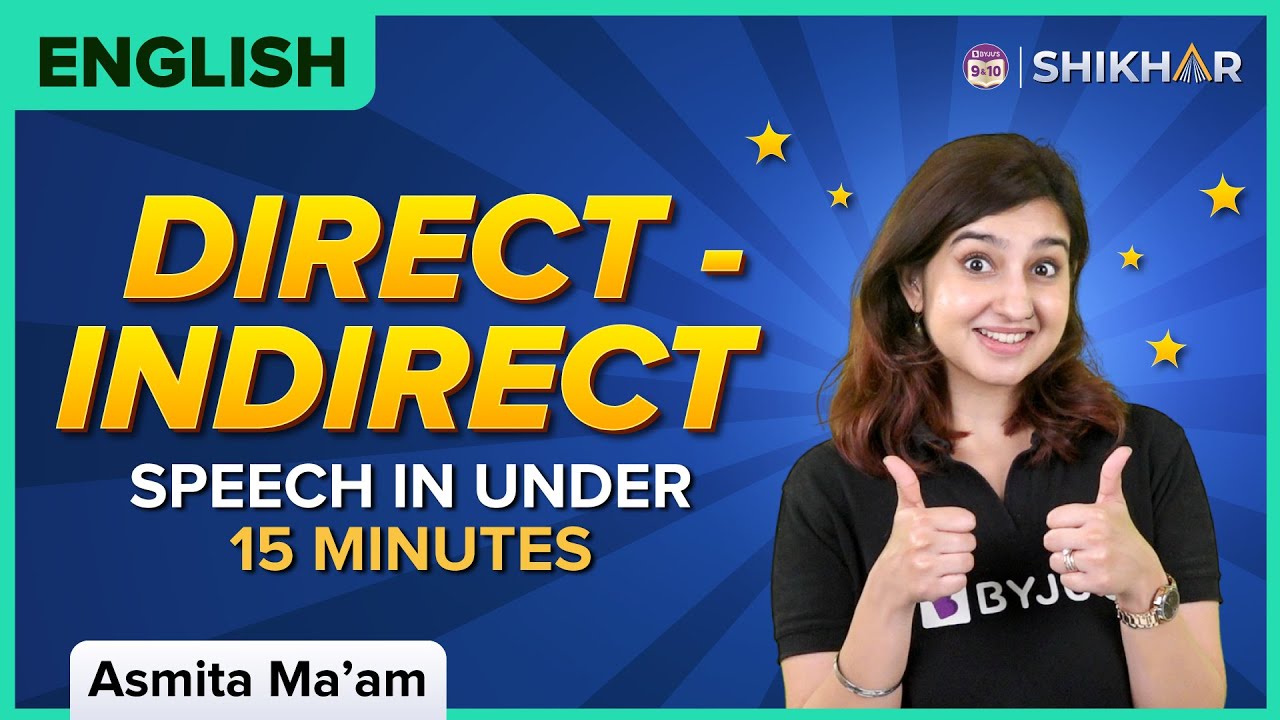BELAJAR DIRECT AND INDIRECT SPEECH (REPORTED SPEECH)
Summary
TLDRIn this video, the presenter explains the concepts of direct and indirect speech (reported speech) in English, providing clear examples and rules for converting direct quotes into indirect forms. Key points covered include changes in tenses, pronouns, time expressions, and sentence structure. The video also explores how to handle questions, commands, and prohibitions in indirect speech. Viewers are guided step-by-step through the process of transforming direct speech into indirect speech with practical examples and tips for mastering these grammar rules in English.
Takeaways
- 😀 Direct speech refers to quoting someone's exact words, usually enclosed in quotation marks, e.g., 'Jono said, 'I'm hungry.''
- 😀 Indirect speech involves reporting someone's words without using the exact phrasing, e.g., 'Jono said he was hungry.'
- 😀 Tense changes are essential when converting direct speech to indirect speech, such as changing present tense to past tense.
- 😀 Pronouns in direct speech are adjusted in indirect speech depending on the perspective, e.g., 'I' becomes 'he' or 'she.'
- 😀 Time expressions like 'now' or 'today' in direct speech change in indirect speech, such as 'now' becoming 'then.'
- 😀 Yes/no questions in indirect speech begin with 'if' or 'whether,' and follow the structure of a statement.
- 😀 Wh-questions in indirect speech are transformed into statements, keeping the structure of the question intact.
- 😀 Commands or imperatives in indirect speech often use phrases like 'asked to' or 'told not to,' e.g., 'He asked me to bring the bag.'
- 😀 Indirect speech helps maintain the original meaning of what was said, even when the exact words are not quoted.
- 😀 A change in sentence structure occurs when converting direct speech to indirect speech, particularly with questions and commands.
- 😀 It's important to practice these transformations and check the tense, pronoun, and time expression changes to master indirect speech.
Q & A
What is direct speech in English grammar?
-Direct speech involves quoting someone's exact words, typically enclosed in quotation marks. For example, 'Jono said, 'I am hungry.''
What is indirect speech in English grammar?
-Indirect speech, or reported speech, is when you convey someone's words without quoting them exactly. For example, 'Jono said that he was hungry.'
What are the main changes when converting direct speech to indirect speech?
-When converting direct speech to indirect speech, four main changes occur: changes in tense, pronoun shifts, changes in time adverbs, and changes in sentence structure.
How does tense change when converting from direct to indirect speech?
-The tense of the verb usually shifts backward in time. For example, present tense in direct speech changes to past tense in indirect speech (e.g., 'I am hungry' becomes 'He said that he was hungry').
Can you give an example of a pronoun change when converting direct speech to indirect speech?
-Yes, in direct speech, 'I' (the speaker) changes to 'he' or 'she' in indirect speech. For example, 'I am tired' becomes 'He said that he was tired.'
What happens to time adverbs when converting direct speech to indirect speech?
-Time adverbs often change. For example, 'now' changes to 'then,' 'today' changes to 'that day,' and 'yesterday' becomes 'the day before.'
How do you change a yes/no question from direct to indirect speech?
-In indirect speech, a yes/no question is turned into a statement. The word 'if' or 'whether' is used, followed by the subject and verb. For example, 'Are you okay?' becomes 'She asked if he was okay.'
What is the rule for changing Wh-questions from direct to indirect speech?
-For Wh-questions, the question structure changes into a statement. The question word (like 'what,' 'where,' 'when') remains, followed by the subject and verb. For example, 'What are you doing?' becomes 'He asked what I was doing.'
How are commands or imperatives converted into indirect speech?
-Imperatives are usually reported using 'to' followed by the base form of the verb. For example, 'Close the door' becomes 'She told me to close the door.'
How is a negative imperative converted into indirect speech?
-A negative imperative, such as 'Don't make me angry,' is reported using 'not to' before the verb. For example, 'My father warned me not to make him angry.'
Outlines

Cette section est réservée aux utilisateurs payants. Améliorez votre compte pour accéder à cette section.
Améliorer maintenantMindmap

Cette section est réservée aux utilisateurs payants. Améliorez votre compte pour accéder à cette section.
Améliorer maintenantKeywords

Cette section est réservée aux utilisateurs payants. Améliorez votre compte pour accéder à cette section.
Améliorer maintenantHighlights

Cette section est réservée aux utilisateurs payants. Améliorez votre compte pour accéder à cette section.
Améliorer maintenantTranscripts

Cette section est réservée aux utilisateurs payants. Améliorez votre compte pour accéder à cette section.
Améliorer maintenantVoir Plus de Vidéos Connexes

REPORTED SPEECH - PENGGUNAAN DIRECT AND INDIRECT SPEECH - RUMUS DAN CONTOH

BAHASA INGGRIS SMA - Reported Speech (Indirect & Direct Speech) | GIA Academy

Direct - Indirect (Reported) Speech in Under 15 Minutes | Class 9 and 10 | English | BYJU'S

Learn English Grammar: DIRECT & INDIRECT SPEECH (REPORTED SPEECH)

Direct and Indirect speech in English - belajar merubah kalimat langsung menjadi tidak langsung

Direct Indirect Speech / Kalimat Langsung dan Kalimat Tidak Langsung
5.0 / 5 (0 votes)
